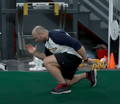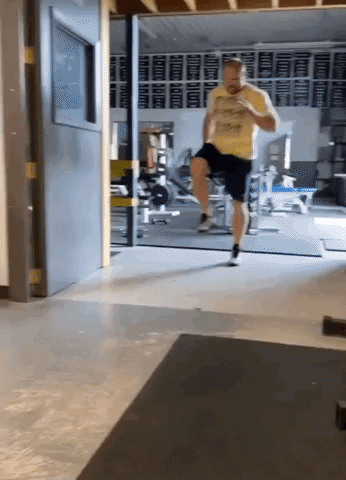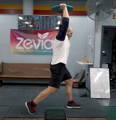How To Get Fast AF
FREE SPEED & POWER WORKOUT!
Download by entering below

How To Get Fast AF
The first thing we have to understand is something that the sporting world has never discussed, and that is transient speed. What is transient speed? Transient speed makes us think to understand speed and agility. Initially, with speed, we think about a 40-yard dash or a 100-meter sprint. But there are other types of speed. Giannis going coast to coast in the sport of basketball is a different type of speed. Jordan Burroughs in the sport of wrestling is another type of speed. Imagine seeing Jordan Burroughs in his heyday running on a track and thinking, “This guy isn’t fast,” and then see him on a wrestling mat and realizing he is extremely fast. Or watch a tennis player like Djokovic going side to side laterally extremely quickly. Transient speed is the type of speed that transfers over to other movements inside the sports world.
Watch an athlete like Micah Parsons come off the edge. He might have three to five-step bursts that are just phenomenally fast which is another type of transient speed. We have to think about all these different types of speed and factor them in when training for sport. It isn’t as simple as running a 60-meter or 100-meter race where we go with a start, acceleration, and max speed; it is more detailed than that. We have to understand different concepts when getting into transient speed concepts.
The Start, Max Acceleration, Top End Speed
We want to focus on the starting position and acceleration when thinking about many sports. Look at basketball or wrestling. The start and acceleration transfer very well to those two sports and many others. The start is going from stoppage or near-complete deceleration into acceleration, which is essentially the first seven to eight steps. Anything passed that enters the realm of maximal mechanics and slows down the slowest.

The Start: Strength Movement – Pause Back Squat
Athletes can do a pause back squat, pause front squat, or pause box squat. A pause on a box does drastically improve the start position. Just make sure to hold a good position while pausing. Pausing in the hole also really improves mobility. Make sure to go up as fast as possible, holding tension in the bottom, and driving up and accelerating as quickly out of the hole helping improve the power output from the starting position.
The Start: Plyometric Movement – 2 Point Start
Get set with one knee on the ground. Think about the downed knee being directly in line with the heel. It is important to practice both sides of this plyometric movement. Focus on holding a forward lean and projecting out. Hold a steep shin angle on the front leg which will help determine how far forward the body will be able to project.

When working on this movement, do two or three reps on each side and hist two or three strides. With the toes curled in, a forward lean, it is also important to have the chest in line with the shin and feel the drives from the quads and glutes.
Acceleration: Strength Movement – Goblet Single-Leg Squat
Acceleration is the key to transient speed. It is the key to being fast in various different sports. 85% of speed training focus in open-skill sports should be on the start and acceleration.
Doing the movement doesn’t require going super, super heavy, but doing it unbroken. Try to lighten up the upper back and trunk so the body does not get pulled forward. We want to really target the glutes and quads when performing the movement while holding good stability. Make sure to use both legs.
Acceleration: Plyometric Movement – Depth Drop To Single-Leg Bounds
Here the movement gets a little bit more complicated and asks for more coordination. To be fast AF, we have to be able to react quickly and project ourselves forward. We have to be able to accelerate.

This movement is great because it can be done basically anywhere. The movement is a depth drop off a 12” box. We want to land, ground, get a little bit of a forward lean, and perform a single-leg bound. As we bound on the single leg, we also want to cycle the leg not being used. Focus on driving the bounding leg’s knee up. Having the chest lean forward with a steep, forward shin angle, the quad and glutes light up to push, push, push through that acceleration position. Think to push the earth away from the body to get the body accelerating forward.
Maximal Mechanics: Strength Movement – Overhead Deficit Split Squat
Maximal mechanics means we want big-time ground reaction forces. We want to be upright with the trunk and perform solid front-side mechanics. We want to be grounding really well by having the middle of the foot to the front of the foot while staying over top of the grounding position. Having dynamic trunk control is pivotal to not losing energy.
Now a lot of athletes tend to struggle with front-side mechanics because of tight hips or a tight groin. The overhead deficit split squat is a really great movement to enhance max mechanics. In the split position, hold a plate overhead while staying really, really upright. The split is best done on two boxes spaced apart to create a deficit. The deficit allows for a greater range of motion when performing the split squat.

We want to feel the shoulders, the abs firing nice and tight, the upper back nice and rigid, and feel the movement all the way into the hips into the grounding position in the middle. And as always, make sure to perform the movement on both legs.
Max Mechanics: Plyometric Movement – Wicket Drill
The wicket drill we need to set up accordingly. The movement can be done with mini-hurdles or tape set up. As we enter into the mini-hurdles, we want to have good posture. We want to be upright. As we ground in-between the mini-hurdles, we don’t want to lean forward but keep the posture rolling and the foot position nice and solid. This is technique work.

There are various ways to use a second stimulus to help with the trunk position. One such way is putting a technique stick on the back. Another is holding your arms out forward like a zombie squat. Doing either of these two methods reinforces the technical aspect of the wicket runs centered on posturing. Remember, the key is dynamic trunk control with optimal ground reaction forces.
Recap
All of these concepts are pivotal to understanding speed to get fast AF. But when it comes to sports, transient speed is more important than track-based speed in the sporting world. This is why we need to think about acceleration and the start position as the main focus.
Related Posts
Blog Topics

Yo, It's Dane
Welcome to the Garage Strength Blog, where it is my goal to provide you with the experience and knowledge I've gained in the strength and conditioning world over many years of learning from both successes and failures. I train elite-level athletes in a multitude of sports from the high school to professional levels, already producing 5 Olympics and 30+ National Champions. If you want to be the next champion I train, check out my strength programs below!
Start Training With Me

Join for free educational videos EVERY WEEK on strength coaching and athletic performance



